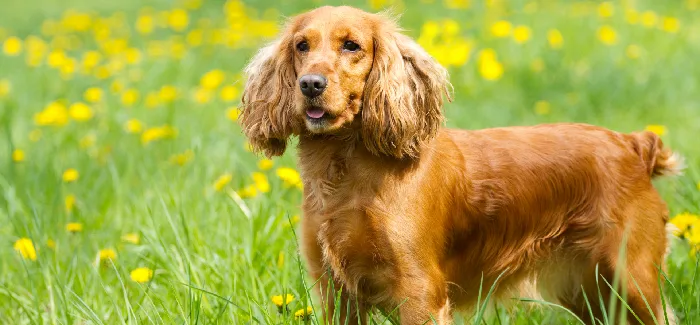Intelligent, Kind, Friendly, Athletic, Affectionate, Playful, Trainable

Welcome to our fun journey about Cocker Spaniel puppies for sale! These cute Cocker Spaniel friends have won many hearts. They are friendly and have beautiful looks.
They have soft fur and big, bright eyes. Cocker Spaniels are more than pets; they are part of the family. They make us happy and keep us company.
When looking for a Cocker Spaniel puppy, it's key to buy from trusted places. This way, we know they are raised right and cared for well. Let's learn more about this wonderful breed together. We'll talk about their special traits and how to find good breeders.
Cocker Spaniel puppies are great for those who want friendly pets. They are loving and fit well into many homes. These dogs bring joy and connection to our lives.
The friendly cocker spaniel is known for its loving nature. It's a great friend for all ages. They bond well with families and love to be near their owners.
These dogs live about 12 years. We can enjoy many happy moments with them.
Cocker Spaniels are good for any home. They are happy indoors or outdoors. They get along well with kids and other pets.
They need regular exercise to stay healthy. Grooming is also important to keep their coats looking good.
| Characteristic | Males | Females |
|---|---|---|
| Weight Range | 25 - 30 pounds | 20 - 25 pounds |
| Average Lifespan | 12 years | |
| Grooming Frequency (Puppy Cuts) | Every 2 weeks | |
| Grooming Frequency (Longer Coats) | At least once a week | |

The Cocker Spaniel breed is known for being very obedient and loving. There are two main types: the American Cocker Spaniel and the English Cocker Spaniel. Each type has its own special qualities that make them loved by many.
The American Cocker Spaniel is smaller. They weigh less than 25 lbs and are 14-15 inches tall for males. They are known for being playful and having a special head shape.
The English Cocker Spaniel is a bit bigger. They weigh 25-30 lbs and are 13-14 inches tall for females. Knowing these differences helps us understand their needs and traits.
Both English and American Cocker Spaniels are friendly, playful, and gentle. They make great family pets. They are also smart and easy to train, but can sometimes be stubborn.
It's important to socialize them well. This helps them grow into happy adults. They can live for 12 to 15 years, bringing joy to our families.
Finding Cocker Spaniel puppies for sale is a fun journey. You can find them through reputable breeders and adoption platforms. These places offer healthy puppies and make sure they are well cared for.
Reputable breeders are a great choice. They make sure puppies come from good families. They also help puppies grow up happy and healthy.
When looking for Cocker Spaniel puppies, check the breeder's certifications and reviews. This way, you get a loving and healthy pet.
Online adoption platforms are easy to use. Pawsypoo have many pets, including Cocker Spaniel puppies. These puppies come with health checks.
These platforms have helped over 4,000 families find pets. You can look at different sites to find the perfect puppy for your home. Remember, adopting a pet means making a big commitment, like the cost of living in big cities in India.
Thinking about getting a Cocker Spaniel? Many things affect the price. Knowing these can help us choose wisely.
The bloodline and registration matter a lot. Puppies from famous lines or KCI registered cost more. For example, a basic Cocker Spaniel in India costs between ₹30,000 to ₹60,000.
But, those with KCI registration might cost ₹60,000 to ₹90,000. Show quality puppies, with even better bloodlines, can be ₹80,000 to ₹1,20,000.
Where you live also changes the cocker spaniel price. Places with more demand and availability see higher prices. Also, the reputation of the breeder plays a part. Good breeders charge more than others.
Areas with more Cocker Spaniels usually have lower prices. This is because certain breeds are rarer in some places.
Understanding about registration, bloodlines, and location helps us pick the right Cocker Spaniel.
Getting a Cocker Spaniel puppy is a big decision. We need to know how much it costs. In India, prices range from ₹30,000 to ₹60,000. This depends on the breeder and the puppy's family history.
Prices for Cocker Spaniels vary by region in India. For example:
This helps us plan our budget better.
Many things affect the price of a Cocker Spaniel. These include the puppy's coat color, family history, where it's from, and how popular it is. Here's a quick look at the prices for different types:
| Breed Variation | Price Range |
|---|---|
| American Cocker Spaniel | ₹35,000 to ₹60,000 |
| English Cocker Spaniel | ₹32,000 to ₹60,000 |
Knowing the price range helps us make a smart choice. It ensures our puppy is healthy and of good quality.
We're excited to welcome a new furry friend home. Preparing for a puppy is key for a smooth start. Having the right supplies makes our home welcoming for our Cocker Spaniel puppy.
Getting the right supplies is important for our Cocker Spaniel's care. Here's a list to help us prepare:
Adding these essential supplies to our preparations creates a caring environment. This helps our puppy adjust easily. It makes them a happy, secure part of our family.
Our Cocker Spaniel puppies need special care for their health. They are usually healthy but can get sick sometimes. Knowing about common health issues helps us keep them well.
Cocker Spaniels can get ear infections because of their ears. Cleaning their ears often helps. They might also get hip dysplasia, which is more common in bigger dogs. Keeping them at a good weight helps.
Eye problems like glaucoma are also a worry. It can cause blindness if not caught early. Taking them to the vet often is key to spotting these problems.
Preventative care is very important. We need to take them to the vet often for check-ups and shots. Feeding them small meals helps them grow right and stay slim.
Grooming them weekly keeps their fur from getting tangled. Giving them supplements like glucosamine helps their joints. With the right care, our Cocker Spaniels will be happy and healthy for a long time.
Training our Cocker Spaniel puppies is very important. Early socialization and learning commands are key. Puppy kindergarten classes help them learn important social skills.
Puppy kindergarten is a great start for our young Cocker Spaniels. These classes teach basic obedience and potty training. They learn to follow commands like "sit" and "down."
Training should be short because puppies get bored easily. Positive reinforcement makes learning fun for them.
Social skills are just as important. We should start socializing them early. This includes meeting different people and dogs.
Classes help them learn how to behave in new situations. Praise and rewards help them feel confident and friendly.
| Training Aspect | Details | Tips |
|---|---|---|
| Training Period | Start as early as 8 weeks. | Consistency is key. |
| Socialization | Integrate with people, pets, environments. | Start early to avoid fear issues. |
| Training Methods | Focus on positive reinforcement. | Short, engaging sessions work best. |
| Common Commands | Teach basic commands like sit, down. | Use treats for motivation. |
| Crate Training | Early bladder control supervision needed. | Use positively; don't punish. |
Knowing what our Cocker Spaniel puppies need helps us train them well. Puppy kindergarten gives them positive experiences. This shapes their behavior and social skills into good companions.
Bringing a Cocker Spaniel puppy home is exciting. We need to make a safe and comfy place for them. A good home helps them grow and feel safe.
We should set up cozy spots for them. These can be crates or special corners with toys and blankets. These places are their own little sanctuaries.
Safe spaces help our puppies feel happy and calm. These areas should be free from dangers like choking hazards or toxic plants. It's also good to let them play outside.
They can be happy in cities or the countryside. Just make sure they have a safe place to play and run.
Playing with our Cocker Spaniel is key to bonding. Fun activities help us spend time together and keep them active. Games like fetch or tug-of-war are great.
Positive play helps with training and builds trust. Cocker Spaniels love to be with their family. So, let's include them in our activities.
Cocker Spaniel puppies are full of charm and love. They make great friends for any family. These puppies are not just cute; they are also very friendly.
They bring joy to our lives. To help them grow well, we need to take good care of them. This means giving them the right food and lots of playtime.
When we think about getting a Cocker Spaniel, we must remember they need lots of exercise. They also need to meet new people and go to the vet often. This keeps them healthy and happy.
It's important to choose a good breeder, no matter where you live. This ensures you get a puppy that fits well with your family. Getting a Cocker Spaniel puppy is a big adventure. It's something to be excited about.
If you want to add a Cocker Spaniel puppy to your family, call us at 8766330856. We can help you with all the details. Let's make a happy home for our new furry friends!
There are two main types of Cocker Spaniels. The American Cocker Spaniel is smaller and playful. The English Cocker Spaniel is bigger and calmer.
The price of Cocker Spaniel puppies varies. It depends on bloodline, registration, and where you are. In India, prices are between ₹30,000 to ₹60,000 or more.
To get ready for a Cocker Spaniel puppy, you need to buy food and water bowls. Also, get high-quality puppy food, a crate, and bedding. Don't forget toys, grooming tools, and a leash and collar. Make your home welcoming for your new pet.
Cocker Spaniels might get ear infections, hip dysplasia, and eye problems. It's important to take them to the vet regularly. Also, keep them healthy with the right food.
Training your Cocker Spaniel puppy is key. Start with socialization and puppy classes. Use positive methods to teach them good behavior and build a strong bond.
You can find Cocker Spaniel puppies for sale through good breeders and online sites like Pawsypoo. Make sure to check the breeder's reviews.
A safe space for your Cocker Spaniel should have comfy bedding and toys. This makes them feel secure and helps them adjust to their new home.
The bloodline of a Cocker Spaniel puppy affects its price. Puppies from champion bloodlines or with registered lineage cost more. This is because of their pedigree and show quality.
Yes, Cocker Spaniels are great for families with kids. They are friendly and love people. They make any family happier and more joyful.